Courage, said we? Audacity, is the correct term! Granted, AMD is a big company, but how can their first attempt in the difficult SSD field have such grit? There is a mystery here which awakens my inner Sherlock Holmes! We promise to get to the bottom of this case and solve the mystery of the AMD R7 240GB.
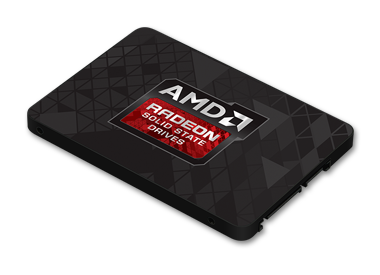
Come Watson, let us proceed to the next page!
[break=From the packaging to the Silicon - What you get]
AMD R7 240GB comes in a paper box, dominated by red and black. It is enclosed in plastic wrap which ensures you will be the first to open the paper box.

|

|
Without the plastic wrap, thing become clearer and you can, if you click on the pictures and see the HD version. read details about the product.
Starting from the front of the package, we can see the logo of AMD, the SSD itself, the fact that this drive belongs to the R7 series and that it has a capacity of 240GB. At this point we have to comment that the R7 series by AMD comprises Low-Range to Mid-Range products. So, it stands to reason that this is what we should expect from the AMD R7 240GB. And we wonder, will there be an AMD R9 SSD?
On the back, on the left side we can see some of the characteristics of the reviewed SSD, which we will go into later, but for now lets keep that it has a SATA III 6GB/s interface, 7mm height to fit inside ultrabooks, supports TRIM and comes with a 4 year warranty. On the right we can see in 12 languages, an effort fo convince us that SSDs are better than HDDs.
There are also some stickers with bar codes and serial numbers and, of course, on the bottom left the logo of the company, OCZ.
Wait a minute Watson! OCZ Storage Solutions, A Toshiba Group Company! That's the secret of the AMD R7 240GB! It is in fact an SSD by the experienced OCZ! The plot thickens!

|

|
Inside the paper packaging, the AMD R7 240GB is accompanied by its generous accessories. We can see the drive itself in a clear plastic protective case, a 3.5" adapter and three leaflets.

The first leaflet concerns the warranty of the AMD R7 240GB, urging us in case of malfunction to not return the product at the retailer where we purchased it but to visit their technical support and RMA gate at the written web address.

|

|
 At this point we will go into some details about the warranty. OCZ is launching a new kind of warranty in the SSD market which promises to make users' lives easier. According to this new warranty which OCZ calls ShieldPlus, you no longer need any proof of purchase for the RMA procedure as the serial number of the product is enough. But this is not even the best part. In case of the product malfunctioning and after you contact OCZ and start the RMA procedure, a new SSD is forwarded to the consumer by the company. After the consumer receives the new drive he sends the malfunctioning one back to the company at OCZ's expense. This warranty is valid for all of Europe and so far only covers the OCZ ARC 100 and the AMD R7.
At this point we will go into some details about the warranty. OCZ is launching a new kind of warranty in the SSD market which promises to make users' lives easier. According to this new warranty which OCZ calls ShieldPlus, you no longer need any proof of purchase for the RMA procedure as the serial number of the product is enough. But this is not even the best part. In case of the product malfunctioning and after you contact OCZ and start the RMA procedure, a new SSD is forwarded to the consumer by the company. After the consumer receives the new drive he sends the malfunctioning one back to the company at OCZ's expense. This warranty is valid for all of Europe and so far only covers the OCZ ARC 100 and the AMD R7.All we can say is a big well done to OCZ for the warranty of the AMD R7 240GB and that we wish other companies would follow the same path.
In the next picture we can see the installation manual of the AMD R7 240GB.

In the last leaflet we find the instructions to download and install Acronis True Image HD, perhaps the most well known drive cloning software, which is bundled with the AMD R7 240GB.

|

|
We are done with the papers and we come to the plastic protective case of the AMD R7 240GB, which also contains the screws that will be needed to install the drive, either as it is or with the use of the 3.5" adapter.

Here is the SSD itself, front and back. Its dual nature asserts itself here as well, as it did on the packaging. So, on the front it is labeled as an AMD, Radeon Solid State Drive,while at the back it is described as an OCZ Radeon R7 Sata III Solid State Drive 240GB.
The sticker on the back side carries information such as the model, the product code, the serial number, the drive's certifications, the country where the drive was manufactured, the Firmware version of the drive, as well as its voltage and amperage.
The four screws in the corners are obviously the ones we must remove to gain access to the interior of the drive. One of them is covered by a sticker bearing the warning that the drive's exceptional warranty will be void if it is removed. There goes the sticker, and so does the warranty and with a Philips screwdriver, there go the four screws.

|

|
Four more scres hold the pcb of the AMD R7 240GB on the casing and a thermal pad brings the controller in contact with the lid we just removed, which doubles as the controllers cooler. A sticker on the NAND chips bearing a code, gives the impression that it concerns the batch of the NANDs used in the particular drive.
Away with all that and in the picture of on the right we can see the essence of the AMD R7 240GB.

|

|
Here we see a close-up of the controller of the AMD R7 240GB which is none other than the known Indilinx Barefoot 3 M00 with the code IDX500M00-BC. It is exactly the same controller we find inside the Vector 150, the flagship of OCZ, which is clocked at 397MHz.
In the picture of the right, we have one of the totally 16 NAND chips on the drive. They are made by Toshiba and have a capacity of 16GB each, bringing up the total capacity of the AMD R7 240GB to 256GB. As the SSD only offers 240 of them to the user, we must assume that the remaining 16GB are used for overprovisioning. The NAND chips used in the AMD R7 240GB are the latest 64Gbit A19nm synchronous MLC NAND by Toshiba and are coded TH58TEG7DDKBA4C. Theoretically they will be a bit slower than the ones used in the Vector and Vertex models due to the smaller lithography, but they will also be cheaper.

|

|
On each side of the PCB there is a chip by Micron which provides the cache memory for the controller of the SSD. Specifically they are 2 chips coded D9PSH, 256MB each, which give a total of 512MB of cache to the Indilinx M00. The rest of their specifications are that they are DDR3 chips clocked at 800 MHz (DDR3 data rate = 1600Mhz) and CL=11. For more information you can visit Micron's web page.
In the picture on the right you can see the other side of the PCB which includes 8 NAND chips, 1 cache chip and on the lower left, the power circuit of the drive.

|

|
Here is the power circuit with its coils and its capacitors and in the middle the chip coded TPS652510 by Texas Instruments which includes three 3 DC-DC converters and the required power MOSFETs, while it can handle input of 4,5 up to 16V. For more information about it, you can visit Texas Instruments' web page.

At this point we are done with the anatomical analysis of the AMD R7 240GB. Join us on the next page to see what all these we have seen can offer us.
[break=Specifications - What is this thing capable of?]
In the following table we can see the nominal performance of the AMD R7 at the capacities it comes in. We observe that the Read Speed is not influenced by the capacity while the Write Speed is somewhat lower only in the 120GB model. The Read IOPS are displayed on the table and rise with the capacity while the Write IOPS are at 90.000 and the same for all capacities. The Steady State IOPS are dependent on capacity and measure 12000 IOPS for the 120GB model, 20000 IOPS for the 240GB model and 23000 IOPS for the 480GB model. Pretty impressive numbers, especially the ones for Steady State, which are exceptional and far above the competition.

Here we can see the physical characteristics and parts of the AMD R7 240GB, which we saw in detail in the previous page.
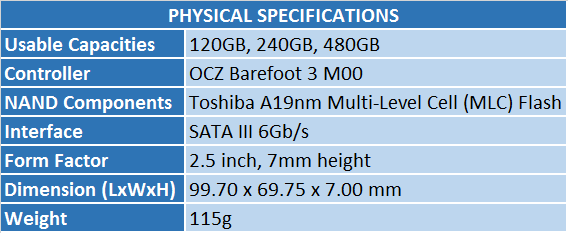
In this table we see the reliability features of the AMD R7 240GB. And first of all the encryption features which are 256-bit AES-compliant and support only ATA passwords while the industry is turning to the safer and easier to use TCG Opal encryption. Be that as it may, desktop users will be fine with it.
Continuing down the table, we see the ECC error correction of the AMD R7 240GB, the support of S.M.A.R.T. and the fact that the AMD R7 240GB is rated for 30GB of writes per day for 4 years.

Here we see the power consumption of the AMD R7 240GB and the high tolerances it has to environmental factors, as all SSDs do.
It is noteworthy that the AMD R7 240GB sadly does not feature low power states (slumber and DevSleep), so its power consumption in idle state is comparatively higher than the competition.
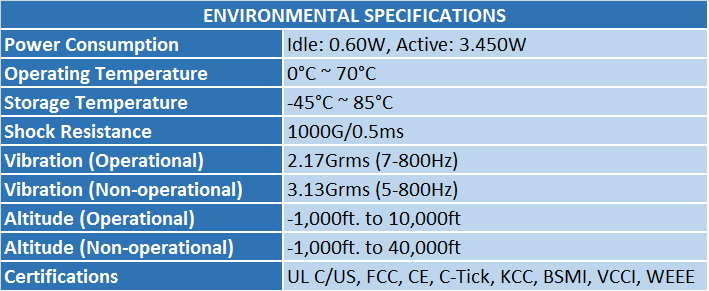
In the next page we will find the analysis of the software that accompanies the AMD R7 240GB.
[break=Software - Spartan but funtional]
The AMD R7 240GB does not include in its package any software but you can go to OCZ's web page and download the Radeon Toolbox.
The software is an exact copy of the known OCZ Toolbox, but with different colors to match the AMD color scheme and has all the basic functions one needs to perform on an SSD. We display and explain its functions below.
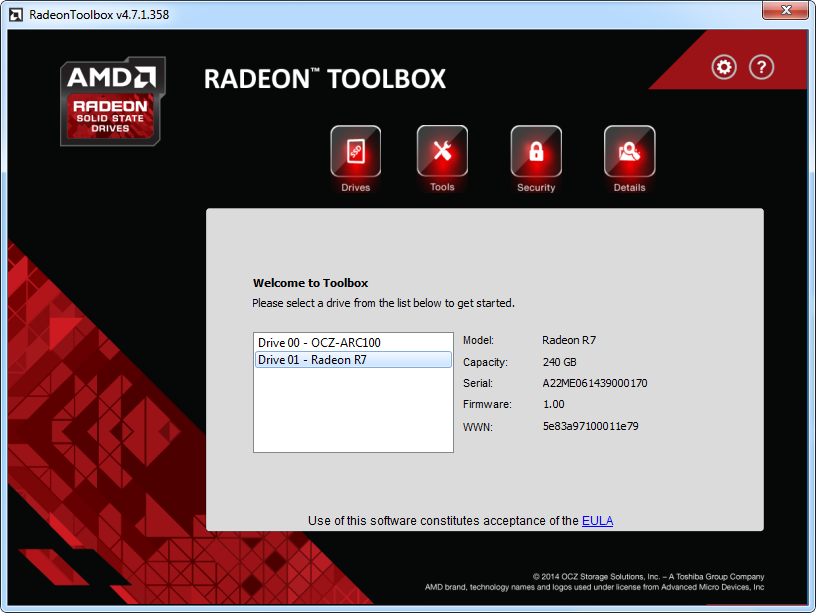
Running the software opens the screen above and in the white box it shows you all the OCZ SSDs in your system. In our case we can see the OCZ ARC 100 which is our OS drive and the Radeon R7. Choosing any of them from the list we see at its right the exact model, the capacity, the serial number, the firmware and the WWN (World Wide Name).
We must note that if no drive by OCZ is found in the system so you can choose it on the list, the rest of the tabs in the program will not open. So, having chosen one drive and pressing Tools, you get the following window...
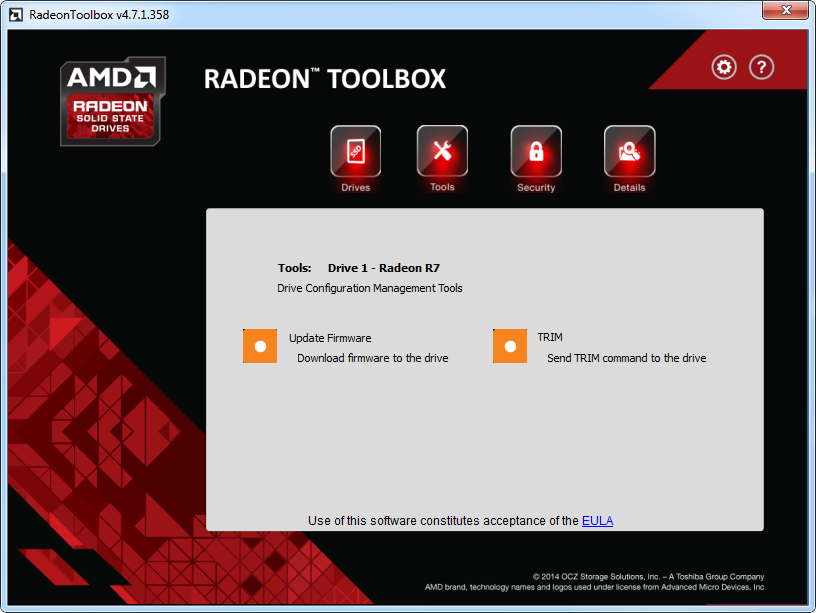
...in which you can download a new firmware, if there is one, and upload it to the drive or send a manual TRIM command.
The third tab is about security...
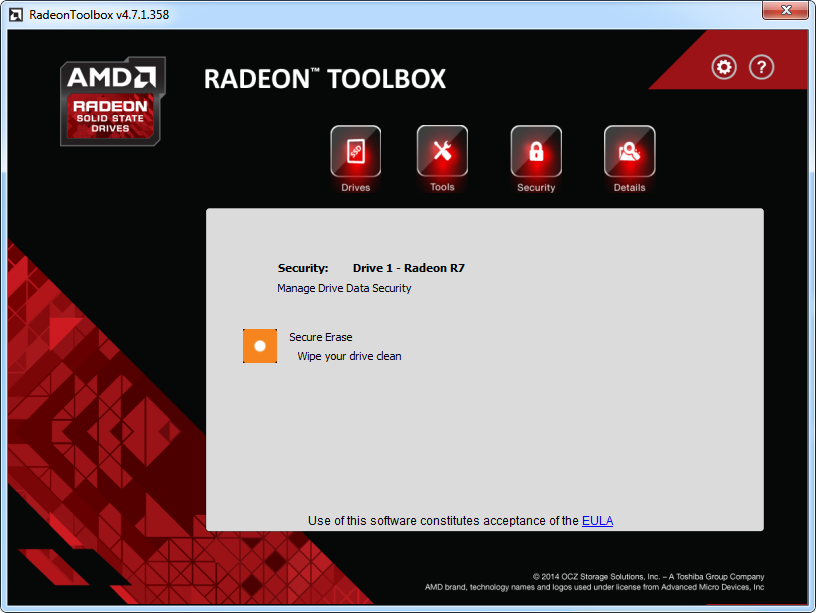
...where we can secure erase our drive and return it to factory state, for security reasons so that one is not able to recover our data (or so they would have us think) but also to return the SSD to a clean state, where all NAND cells are clean and ready to write data. This procedure, contrary to what one might thing, is completed rather fast.
The last tab is the Details tab...
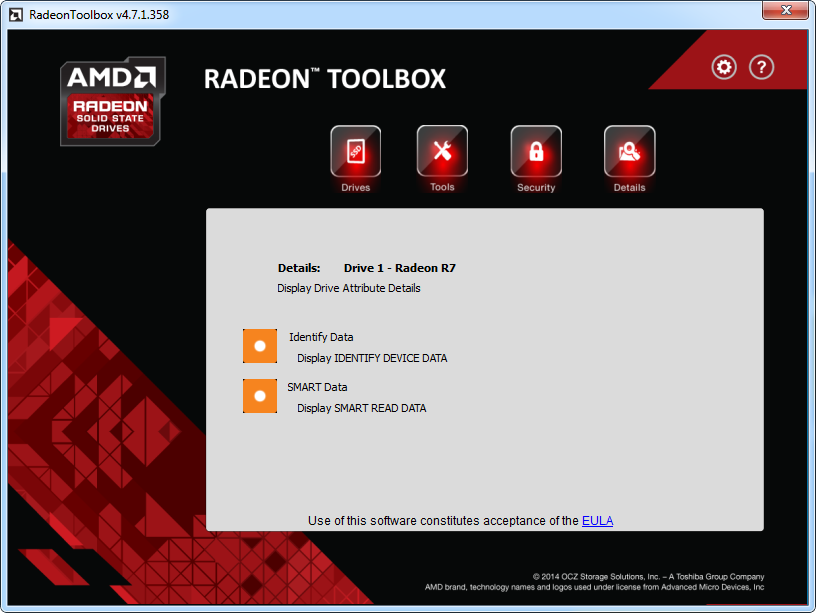
...where you can get details about your SSD and its S.M.A.R.T. status.
Choosing the security button on the top...
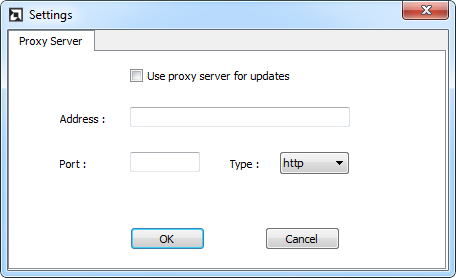
...just gives the option to perform the firmware downloads through a proxy serves and help...
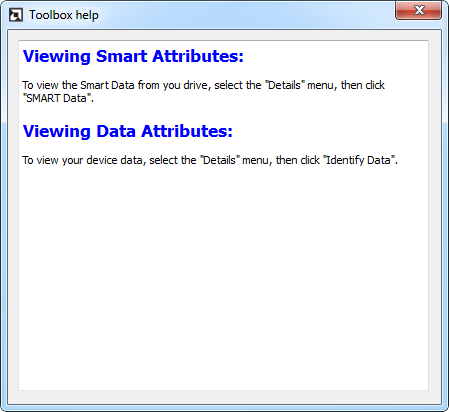
...guess what, yes!, gives information about our choices in the program.
On the whole we can say that OCZ's software, although unimpressive, performs all the basic functions it should, while the only missing thing we would like would be to include a guide to improving the settings of windows to run on an SSD drive.
[break=Our Test system and methodology - Let's see, what are we using and how?]
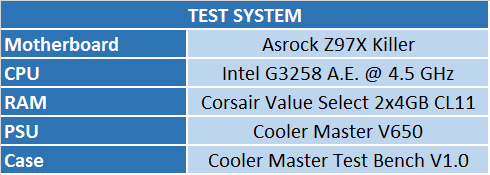
Our test system is based on the Asrock Z97X Killer. This particular motherboard sports SATA III, SATA Express and Μ.2. interfaces making it able to support all SSDs in the market, currently and in the near future. Thus it provides the means to make direct comparisons on the same system.
The CPU is the Intel G3258 Anniversary Edition, with unlocked multiplier which allowed us to easily overclock it to 4,5 GHz. Keeping in mind that the SSD test with high IOPS require hick clocks but run on only one thread, this particular CPU is perfect for our tests.
The RAM is at 8GB which more than covers our needs for the tests, The PSU is the V650 by Cooler Master and the system is housed by the Cooler Master Test Bench V1.0.
Our warmest thanks toAsrock and Cooler Master for the parts they provided for the construction of our test system!
The operating system on which we run our tests is Windows 7 64bit and it includes, aside of all the drivers, the basic programs that come with the motherboard so we can achieve a more realistic and close to fact test environment. The driver of the SATA controller used was the Intel 13.10.1058, obviously in AHCI mode.
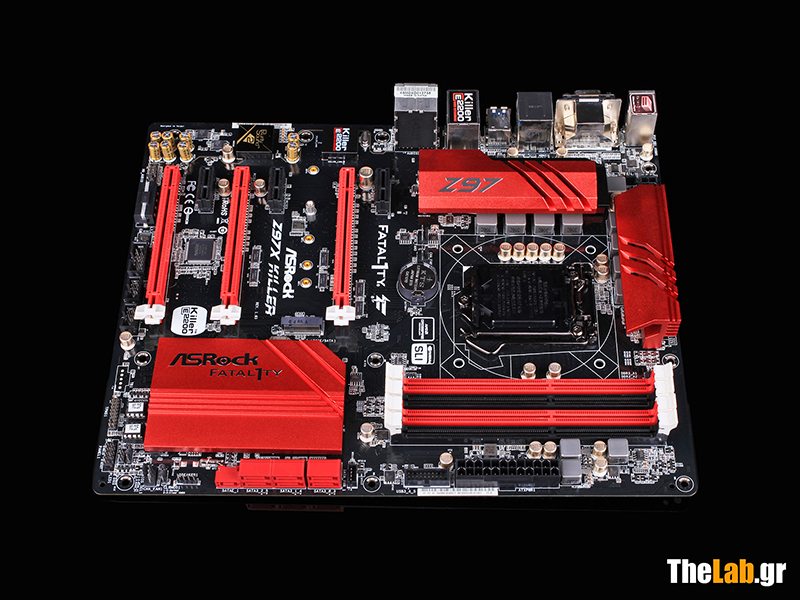
The tests which the AMD R7 240GB will undergo are divided into 4 categories:
1: Synthetic benchmarks on an empty drive, where the tested SSD is a secondary drive to the test system, empty and relaxed. These are the perfect conditions you will never see in real usage.
2: Synthetic benchmarks on a system drive, where the operating system is installed in the tested SSD. Here things come a little closer to reality, but synthetic benchmarks are still synthetic.
3: Steady State Benchmarks where we measure the performance of the SSD while it writes random data for a prolonged period of time so it reaches its worst possible performance. Here things are the opposite of before and thus very unfavorable and unlikely to appear during the usual home usage. But they are the rule in database and file servers.
4: Real Life Tests! Here, using the special suite created for us by the programmer Stelios Sifakis (whom we thank!), we perform some of the most usual tasks and time them. In these tests we place the most gravity for the score as they show the real experience a user will have.
The SSDs included in our comparison are the Samsung 840 EVO 250GB, the Kingston SSDNow KC300 240GB, the OCZ ARC 100 240GB, the fastest until now Samsung 850 Pro 256GB and of course our leading actor, the AMD R7 240GB.
Stay tuned. After the tests there is commentary and score!
[break=Synthetic Benchmarks on an empty drive - We start easy]
The bench is set and the AMD R7 240GB lay down bravely to take the torture.
The HD Tune Pro 5.50 measures the reading and writing IOPS in unpartitioned SSDs. Lets see how the AMD R7 240GB fares against its competitors:
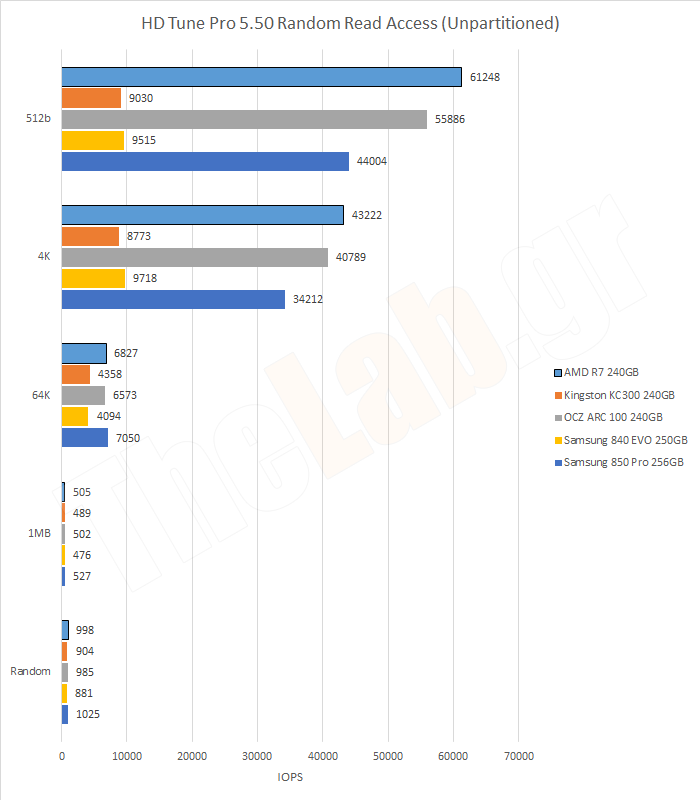
In the Read Tests of the HD Tune Pro 5.50 the AMD R7 240GB takes an easy victory, starting our tests on the right foot...
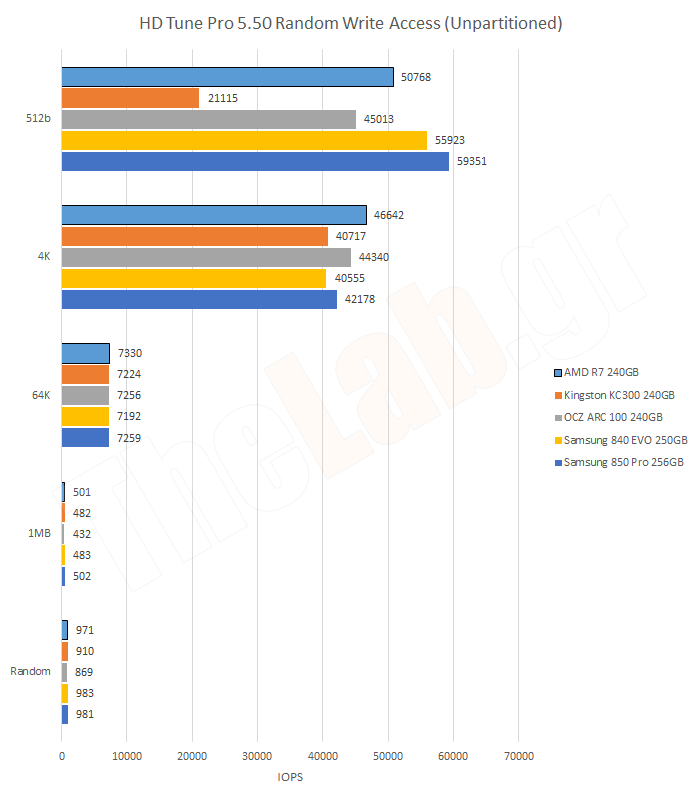
...while in the Write Tests, where differences are smaller, we would have to say that it tied the Samsung 850 Pro 256GB for first place. Not bad at all!
We continue with the Average Access tests of AIDA 64 4.50. With the AIDA 64 Average Read Access and Average Write Access, executed in a drive without partitions we see the response time of the SSD to various requests. In other words, we measure its latency. Here, lower is better.
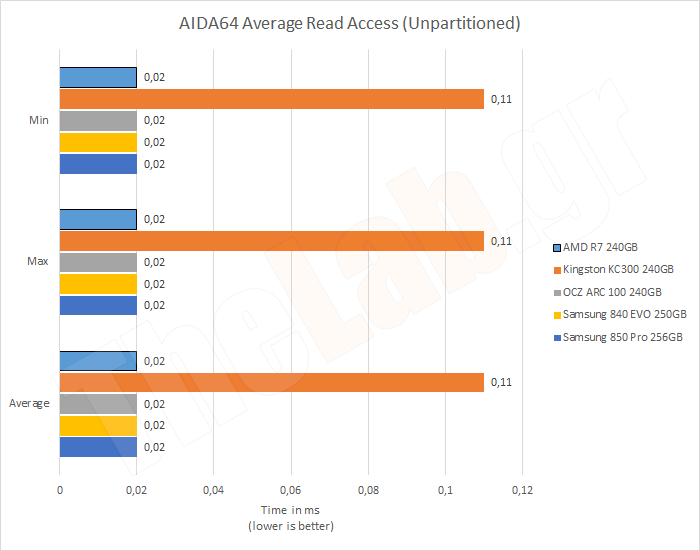
In the Average Read Access, all the SSDs tie for first place, except the Kingston SSDNow KC300 240 GB which has a significantly higher latency.
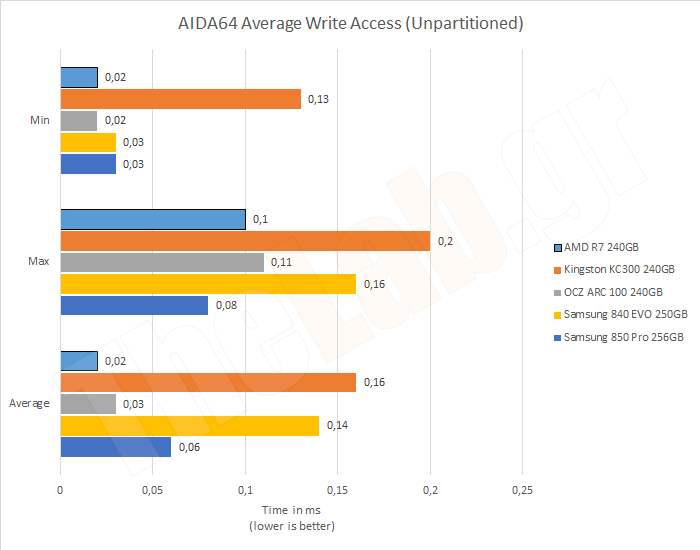
In the Average Write Test, the AMD R7 240GB keeps its average latency at 2ms and gets another victory!
Following is the AS SSD Benchmark, version 1.7.4739.38088.
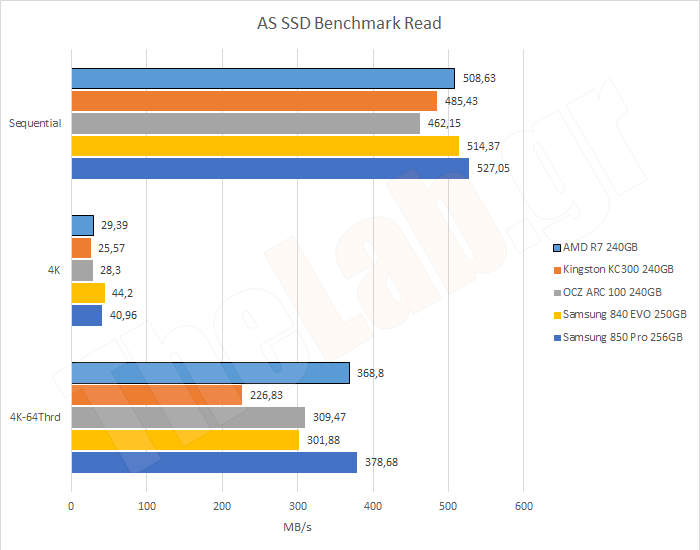
In the read test the AMD R7 240GB stays on the heels of the Samsung drives, except the 4K Read Test, where it lags behind.
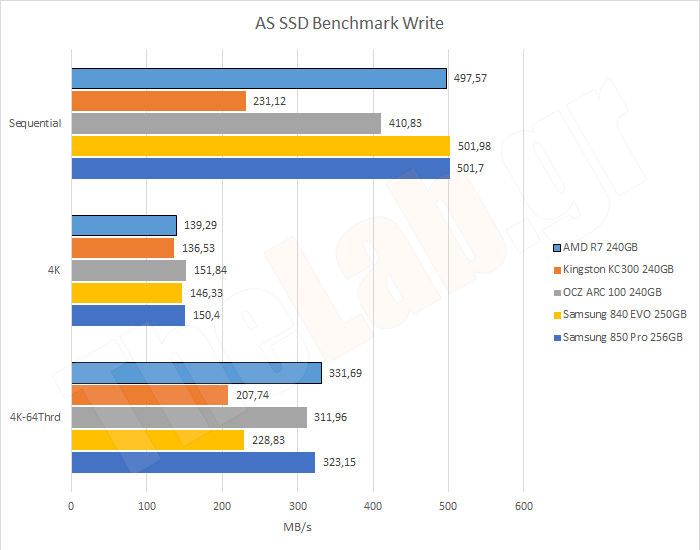
In the Write Tests it fares better and we would say that on the whole it shares first place with the Samsung 850 Pro 256GB.
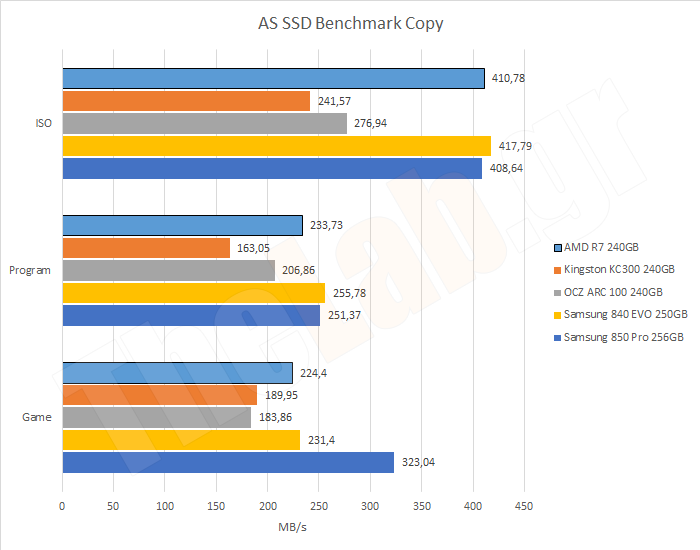
In the copy tests the AMD R7 240GB comes third, with its best performance in the ISO Test and its worst in the Game Test.
Following are the tests of the CrystalDiskMark 3.03b x64.
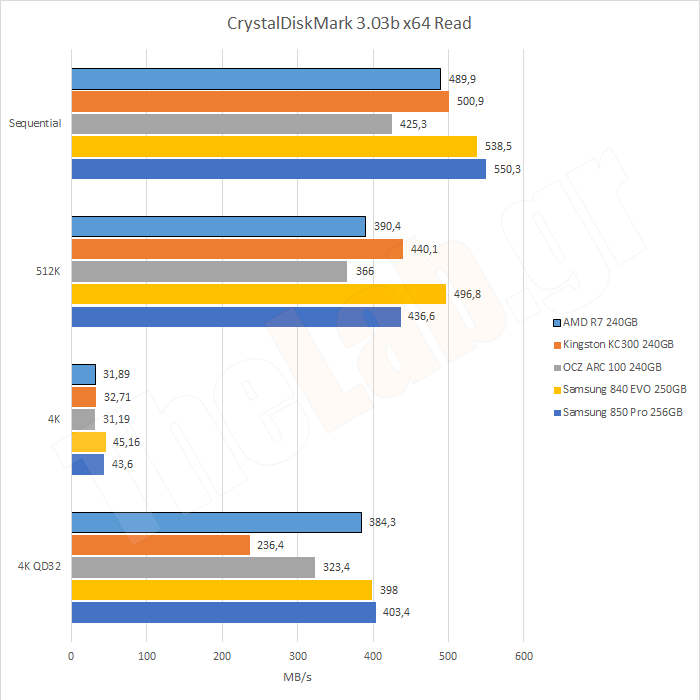
In the read tests of the CrystalDiskMark the AMD R7 240GB does not fare well.
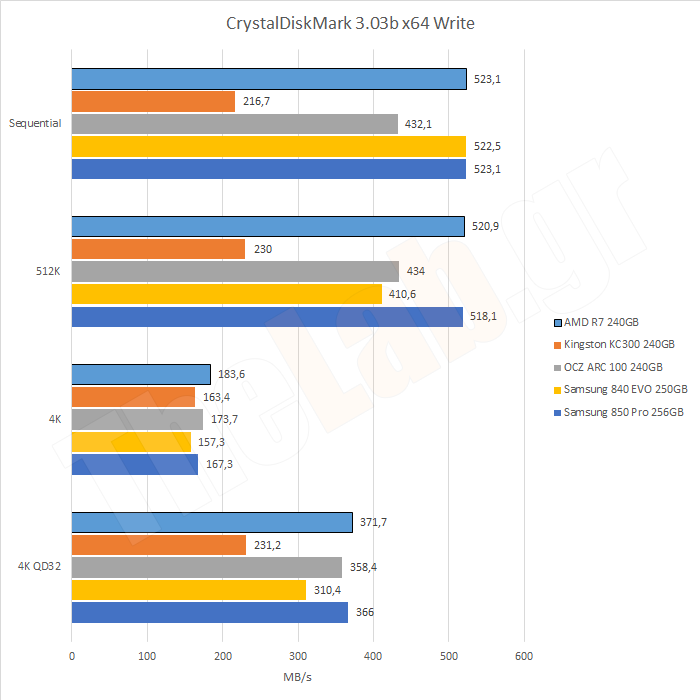
On the contrary, in the Write Tests it comes first in every single test!
Moving on to the score from the Anvils Storage Utilities 1.1.0...
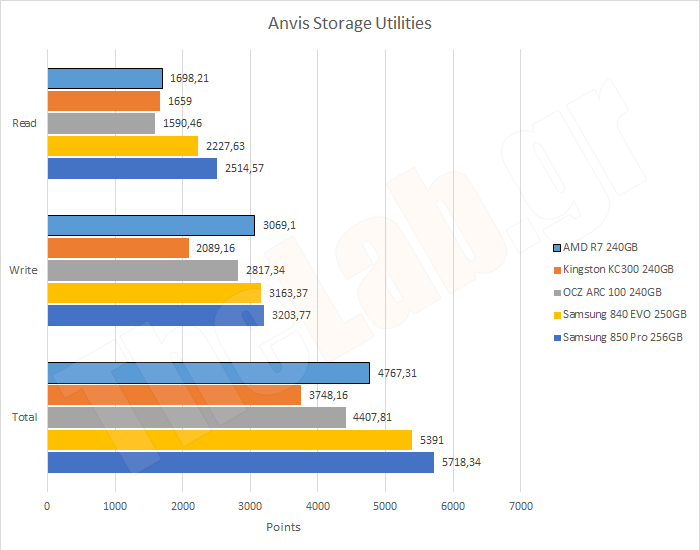
...where the AMD R7 240GB gets the third place, behind the drives by Samsung.
We now come to the suites of Futuremark whom we older guys remember as MadOnion. These suites try to simulate real working conditions. Lets start with the PCMark 05.
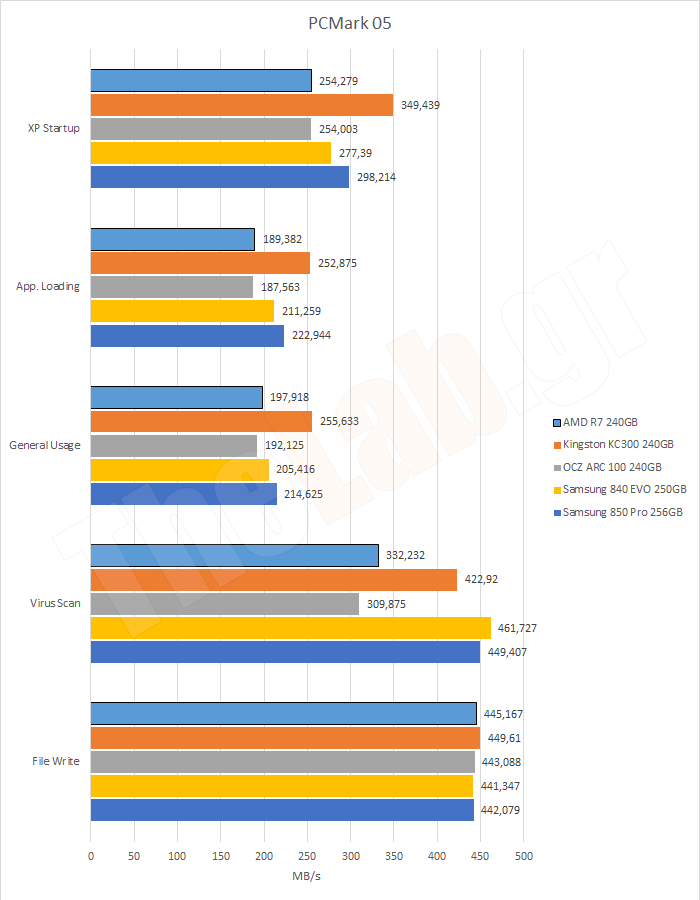
Here the AMD R7 240GB does not do so well, especially in the Virus Scan Test.
Going on to the more contemporary PCMark7.
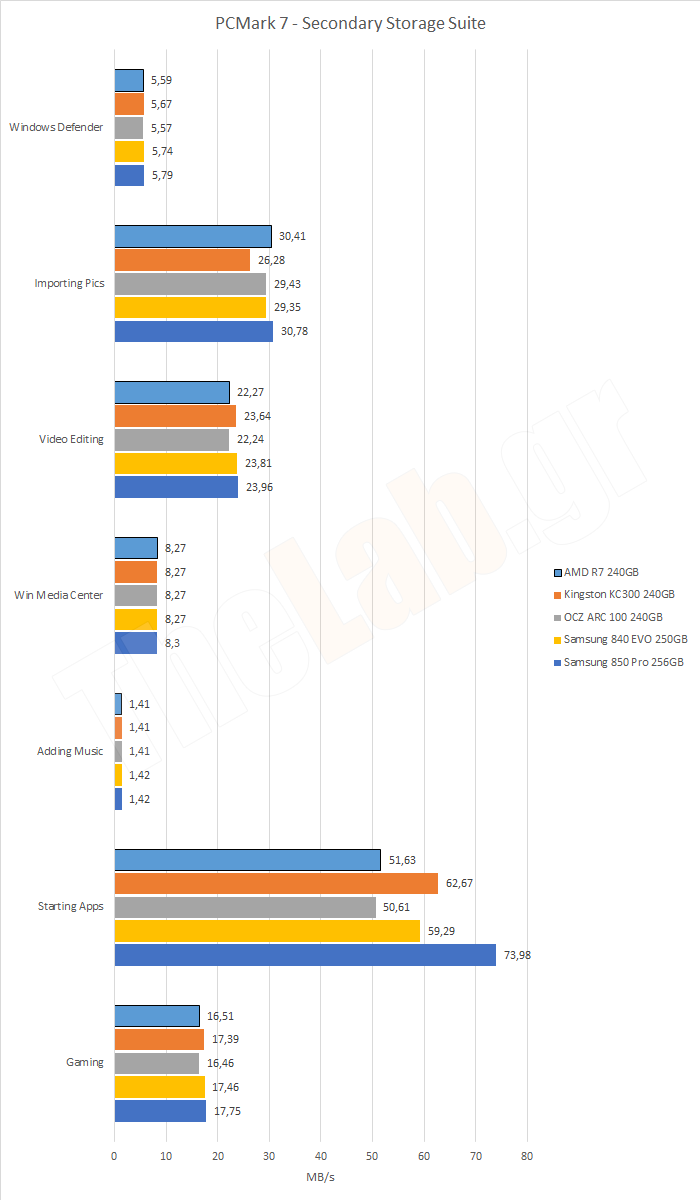
In this test the AMD R7 240GB keeps close to the competition, except in the Starting Apps test where if falls significantly behind.
And we conclude this series of tests with the most recent PCMark8, where the results are in seconds and lower is better.
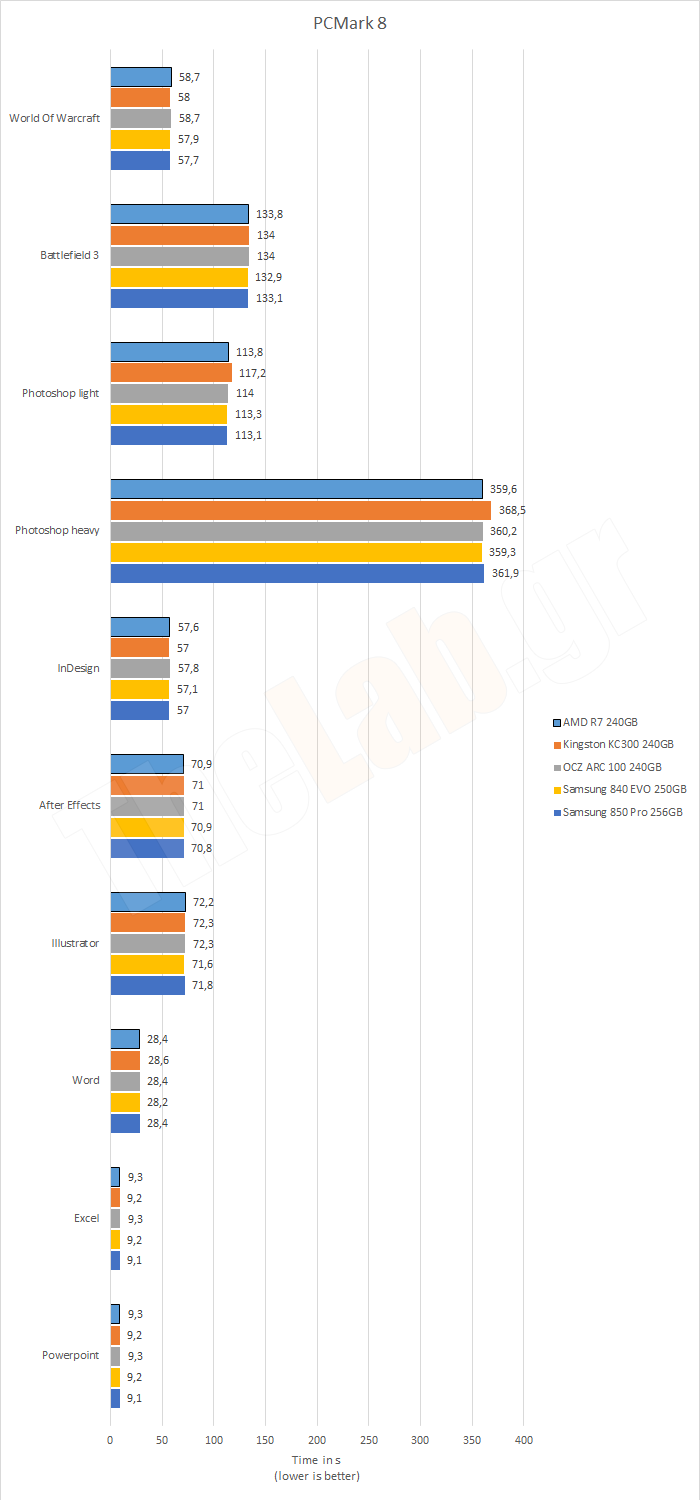
Here, excluding a weakness of the Kingston SSDNow KC300 in the Photoshop tests, the differences are insignificant.
Thus, we conclude the synthetic benchmarks on an empty drive with the impressions the AMD R7 240GB being generally positive. We have to notice that the Performance in some of the tests is exceptional while in others it is unexplainably low. Perhaps a better optimized firmware could solve issues such as the low performance in Virus Scan.
[break=Synthetic Benchmarks on a system drive - Things are getting interesting]
We are making things a little harder now, running the same benchmarks but this time the operating system is installed on the SSD tested.
Once again we start with the HDTune Pro 5.50 but this time obviously on a partitioned drive and we only run the read test as the write test is destructive and would have erased all data on the drive.
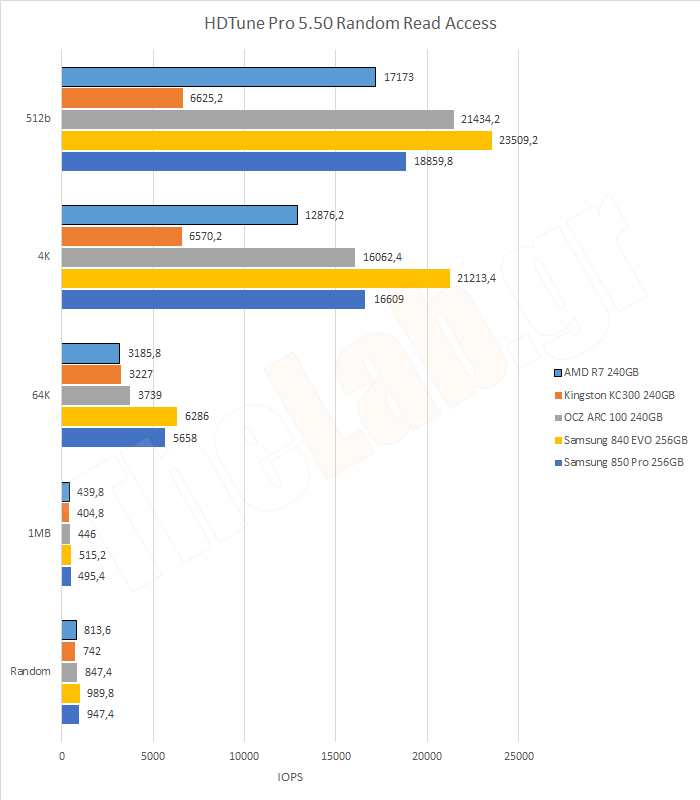
With the OS installed in the drive the situation in HD Tune Pro 5.50 changed with the AMD R7 240GB getting fourth place, behind the SSDs by Samsung but also the theoretically lower OCZ model, the ARC 100 240GB.
We continue with the Random Read Access of AIDA64 4.50, on a partitioned drive now. The Random Write Access, being destructive, is omitted.
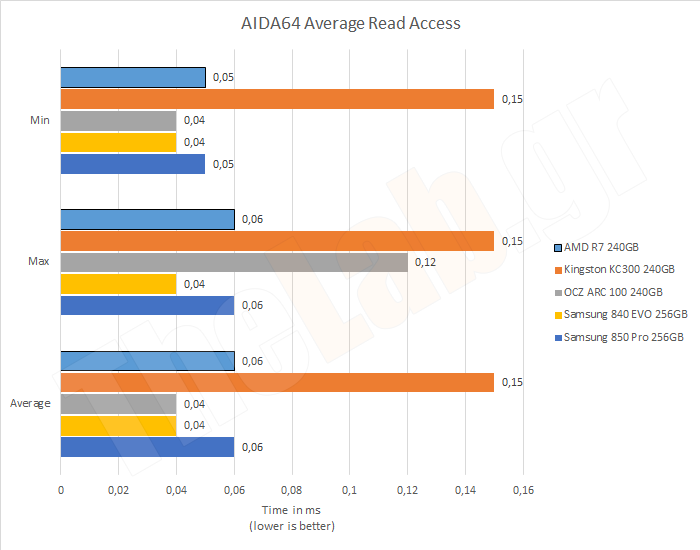
Here the AMD R7 240GB has the same performance as the Samsung 850 Pro 256GB and lags behind the Samsung 840 EVO 256GB and OCZ ARC 100 240GB.
Going on to the AS SSD Benchmark version 1.7.4739.38088.
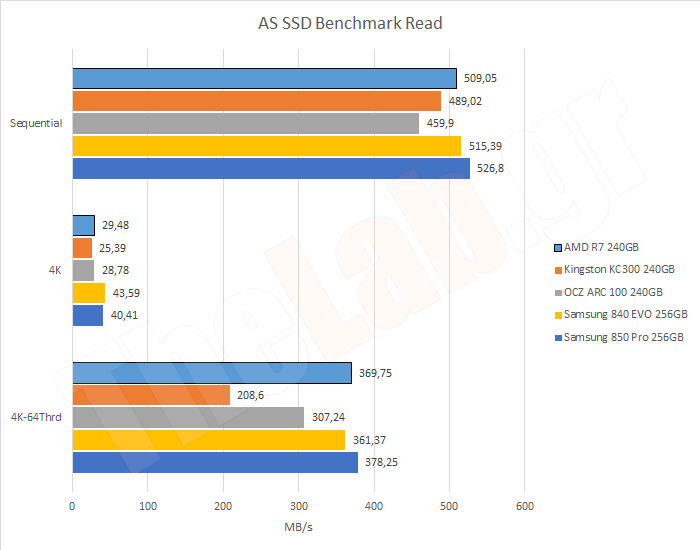
In the Read Tests AMD R7 240GB comes third while...
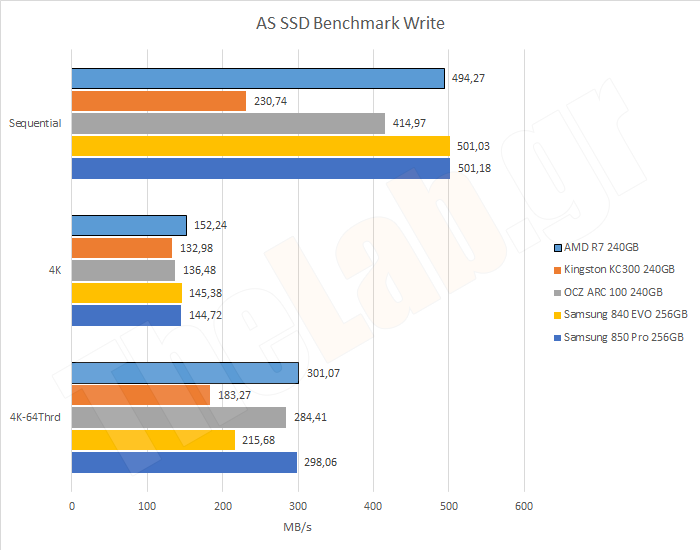
...in the Write Tests it keeps the first place it had in the empty drive tests.
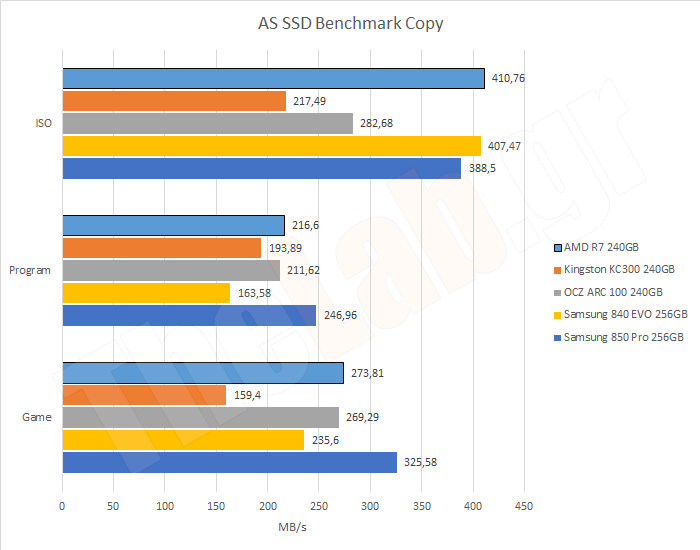
In the Copy Tests, with a first and a second position, we would say that on the whole it comes second only to the Samsung 850 Pro 256GB.
Following are the tests of the CrystalDiskMark 3.03b x64.
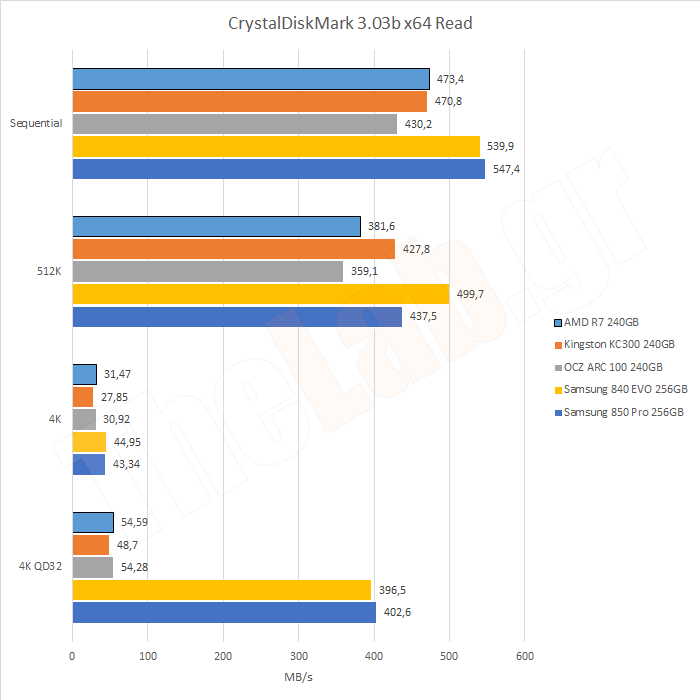
The presence of the OS does not seem to effect this test and so we again see the AMD R7 240GB finishing in the third place.
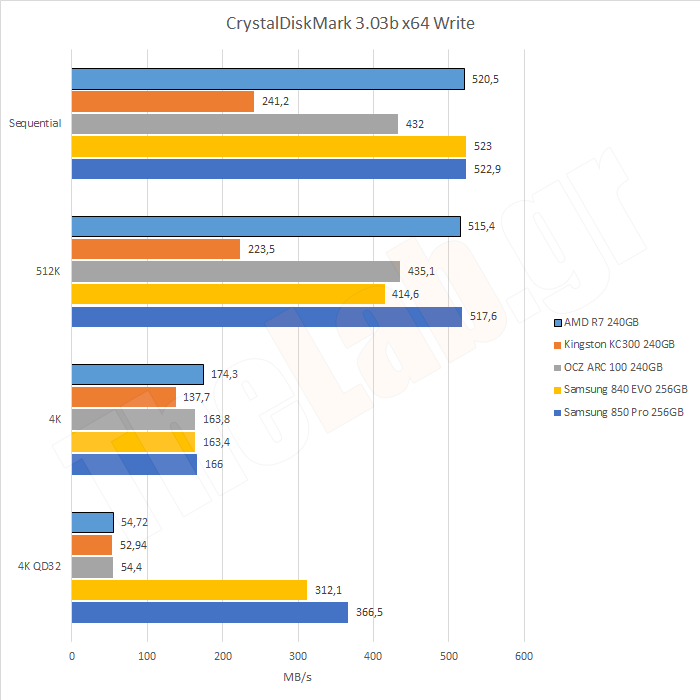
In the Write Tests the AMD R7 240GB rivals the Samsung 850 Pro 256GB everywhere but the 4K QD32 test, where instead of getting a performance boost compared to the 4Κ Test as is expected, we see a performance decrease. The same thing is true for the OCZ ARC 100 240GB and the Kingston KC300 240GB. Seems like a firmware issue.
Continuing with the Anvils Storage Utilities 1.1.0...
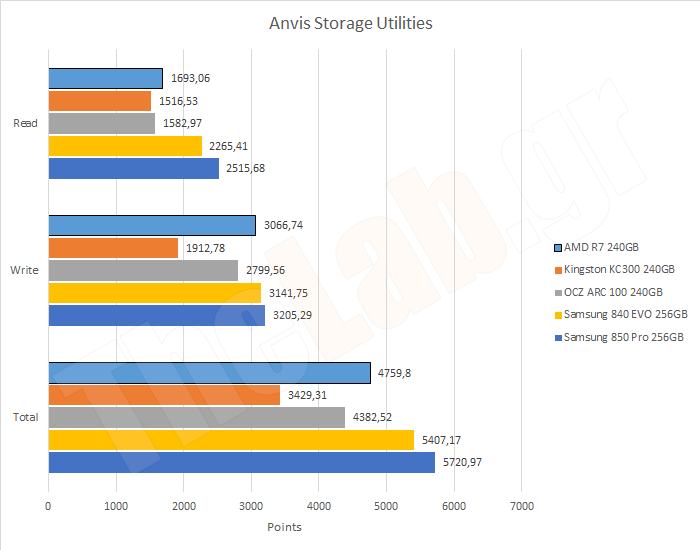
...where the results are like to the ones on empty SSDs. The AMD R7 240GB keeps the third place.
Following are the tests of Futuremark. In all the tests of PCMark05, PCMark7 and PCMark8 the results are similar to the ones on the empty drives. If you don't believe us, here they are:
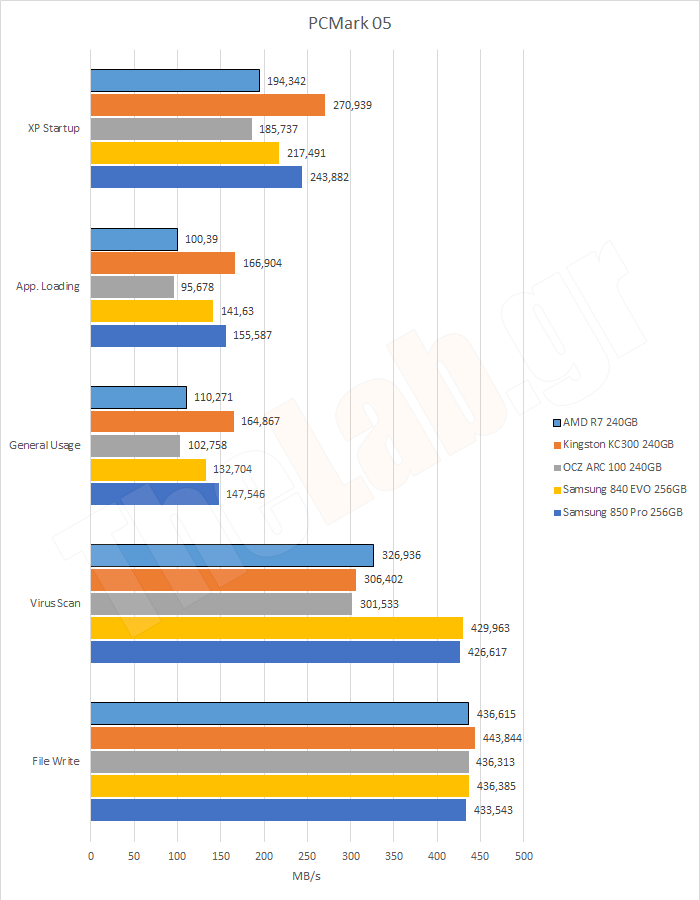
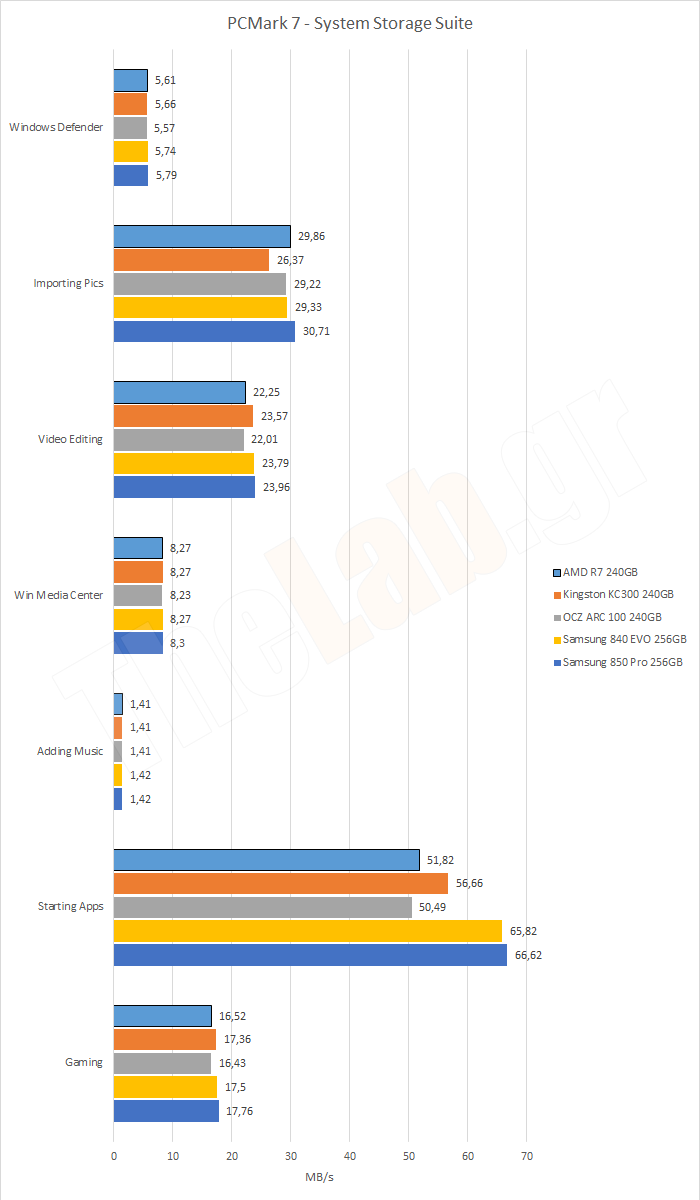
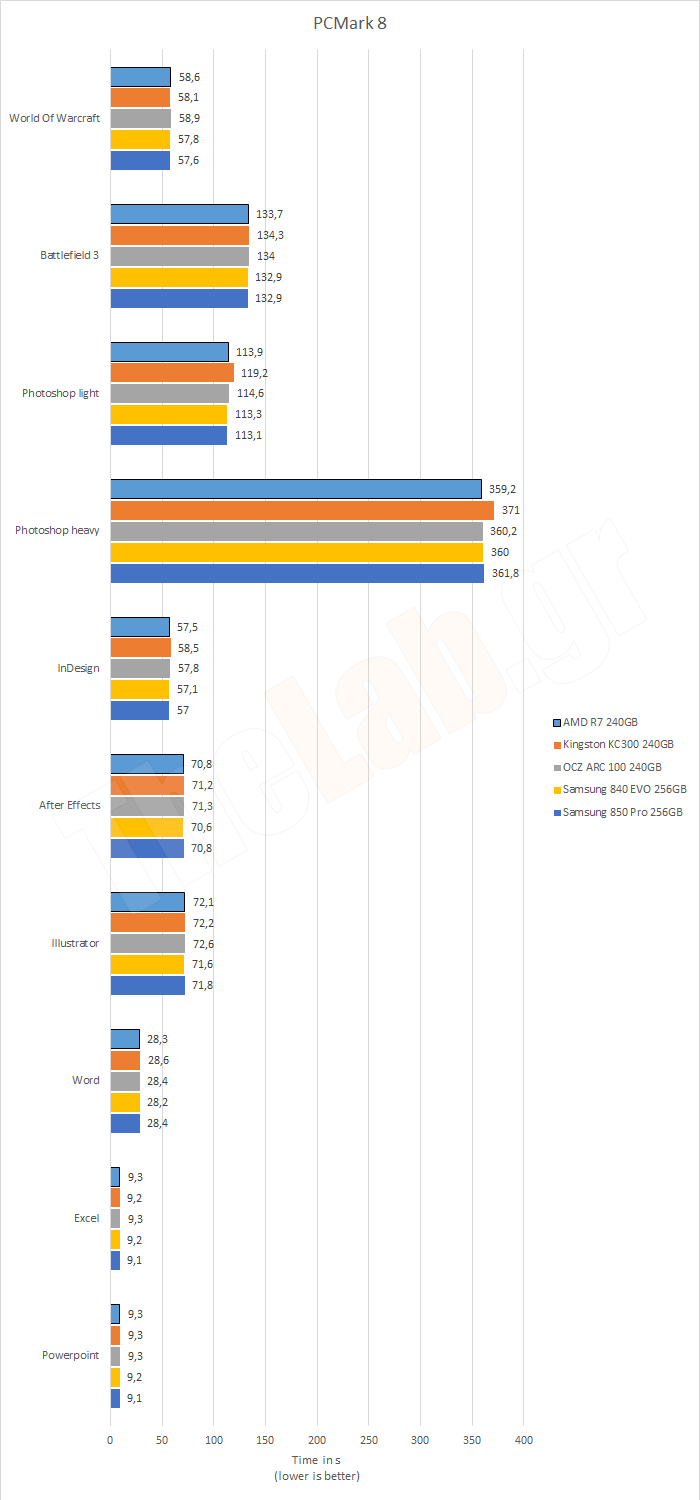
And we finish with BootTimer which measures the time from the loading of the windows kernel until the desktop is usable.
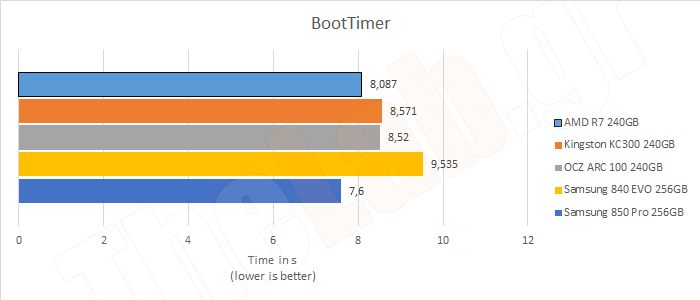
Here the AMD R7 240GB came second, after the lightning fast Samsung 850 Pro 256GB, coming less than half a second behind it and leaving the rest more than half a second behind itself.
This concludes the synthetic benchmarks on a system drive. The AMD R7 240GB was decent, with some obvious weaknesses in certain tests.
Let's hit the tough road!
[break=IOMeter - We press it, can it take it?]
The next test is purely sadistic. We make the SSD write random 4K packages for 12 hours straight without resting and measure its IOPS every five minutes. After some time and as the garbage collection and trim features do not have time to work, the SSD reaches a steady state where every write has to preceded by a deletion of the NAND cell and the SSD operates at its worst performance.
This case is very unlikely to occur in light, casual usage but it is the norm in database and file servers. You should consider the following results according to the heaviness of your workload .
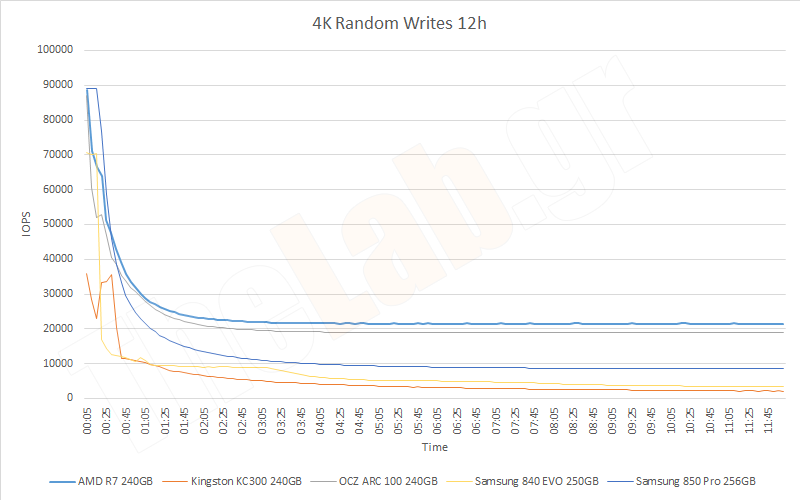
OCZ takes pride in the performance of its SSDs in this particular test, both of its higher models and, as we can see here, the AMD R7 240GB that sweeps the floor with its competition. Any comparison is unnecessary.
Following is the mixed workload test. SSDs in a system rarely do 100% reads or 100%% writes like in the synthetic benchmarks. In the following test we start with three five-minute tests of 100% random reads and keep the average. We continue with three five-minute tests of 95% random reads and 5% random writes and keep the average and so forth as indicated in the graph until we get to 100% random writes. Note that this particular test is run on a drive that has already reached steady state and tries to simulate heavy multitasking.
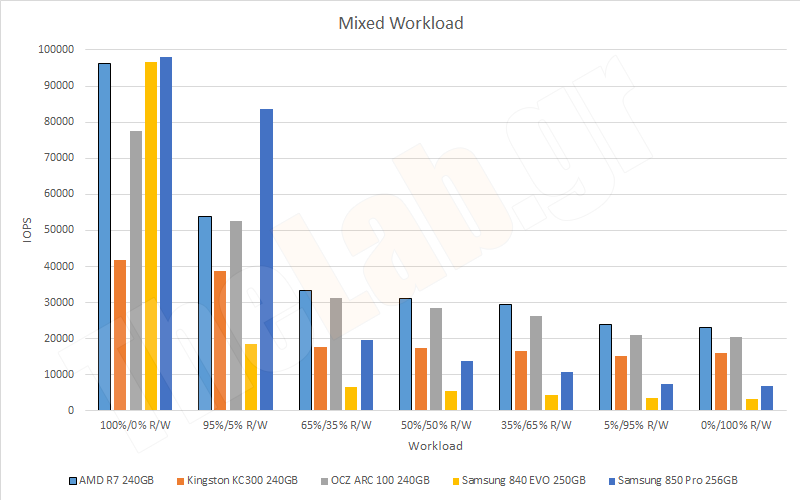
As expected, the AMD R7 240GB storms this test as well.
Finishing these very hard tests, we have to stress that it is a very rare occasion to find such extreme conditions in normal everyday use. Their value is to show us the other side of the synthetic benchmark coin and let us try to find the truth somewhere in the middle.
But instead of guessing we have a better suggestion. The suite of Real World Tests is coming to clear the field, with true tasks in windows and exact timing.
[break=Real Life Tests - How is it in real life?]
We start with the windows startup time test. One might ask, didn't we already do that with BootTimer? As we said, BootTimer measures the time from the loading of the windows kernel until the desktop is usable. But windows itself records in the event viewer the total time of the windows start up, until all services are loaded. As reason indicates, this time is significantly longer and in particular...
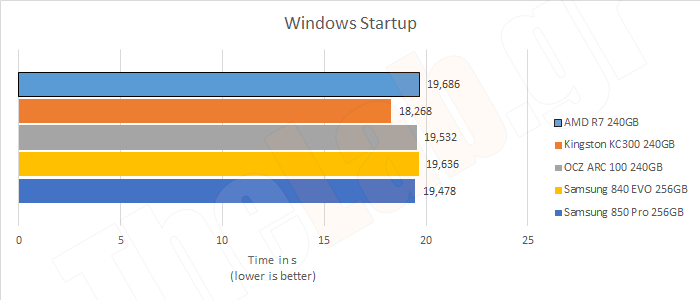
...AMD R7 240GB is packed very close together with the rest of the SSDs in the test, except the Kingston KC300 240GB which is faster by 1.3 seconds.
We continue with real file copying.
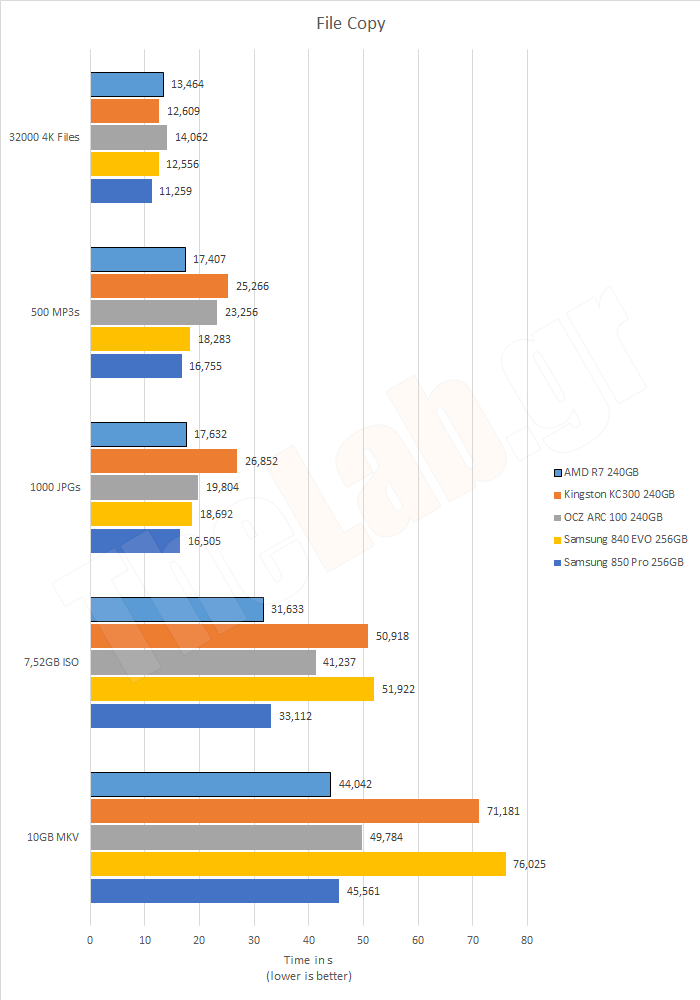
We copy 32000 4K files, 500 MP3s, 1000 21MP JPGs, a 7,52GB ISO 7.52GB and a 10GB High Definition MKV movie. The respective times are shown in the diagram above with the AMD R7 240GB getting second place, behind the Samsung 850 Pro 256GB.
Next, we will store a folder containing the setup of the Office 2013 in a rar file (using the "store" setting)...
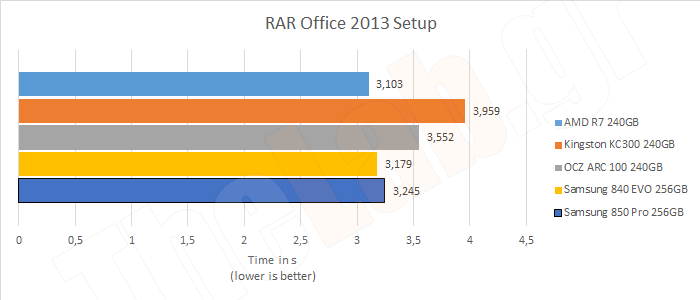
...where the AMD R7 240GB is the fastest and then we will decompress a - compressed - rar containing the setup folder of Office 2013.
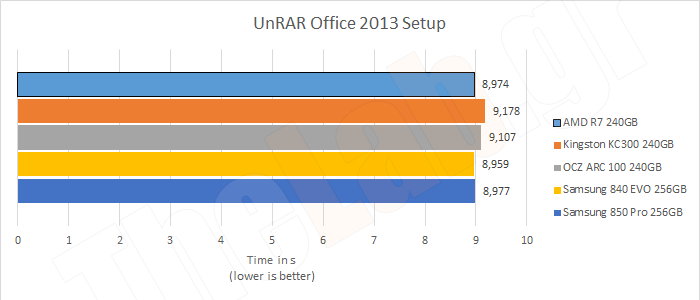
Here the best time is achieved by the Samsung 840 EVO 250GB with the AMD R7 240GB following very closely.
We continue with a virus scan of the system32 folder of windows using the Avira Antivirus, where...
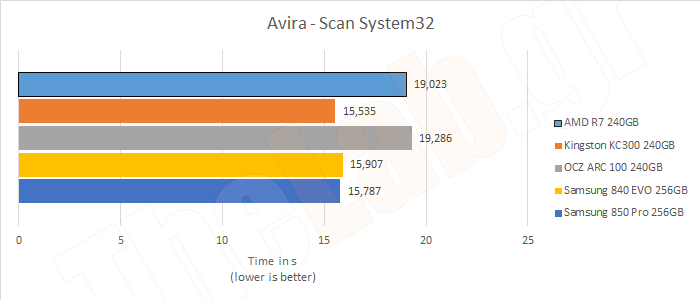
...the AMD R7 240GB displays once more its weakness in Virus Scanning.
Next we will open a 324MP TIF file with Photoshop CS6 save it as BMP and close Photoshop.
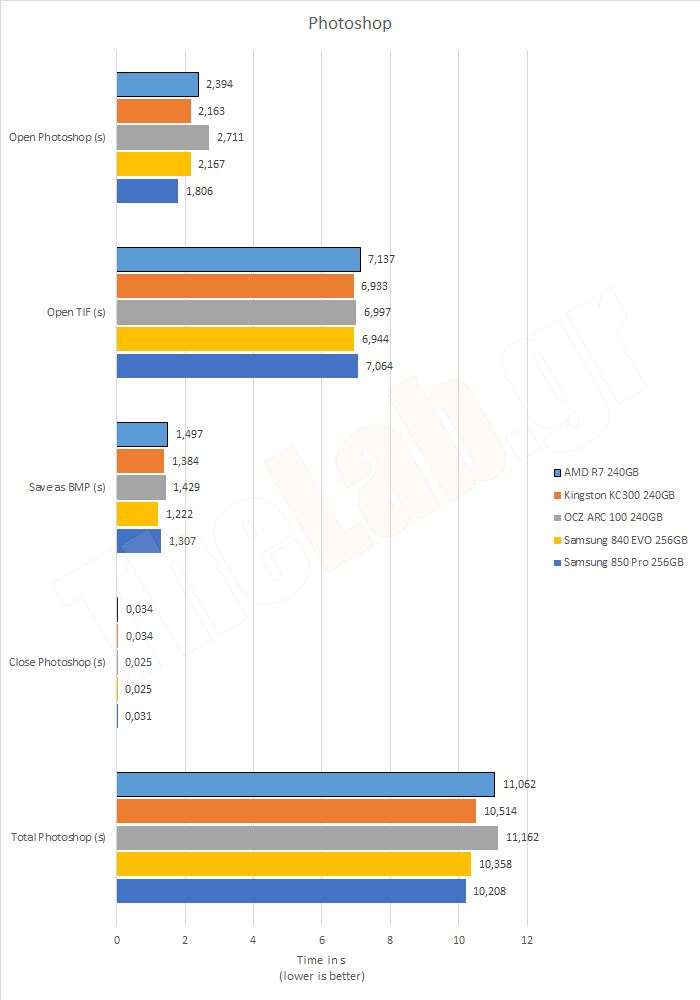
In this test the [AMD R7 240GB did not do very well and got the fourth place.
Then we open Word 2013, load a huge DOCX with images links etc, save it as DOC and close Word.
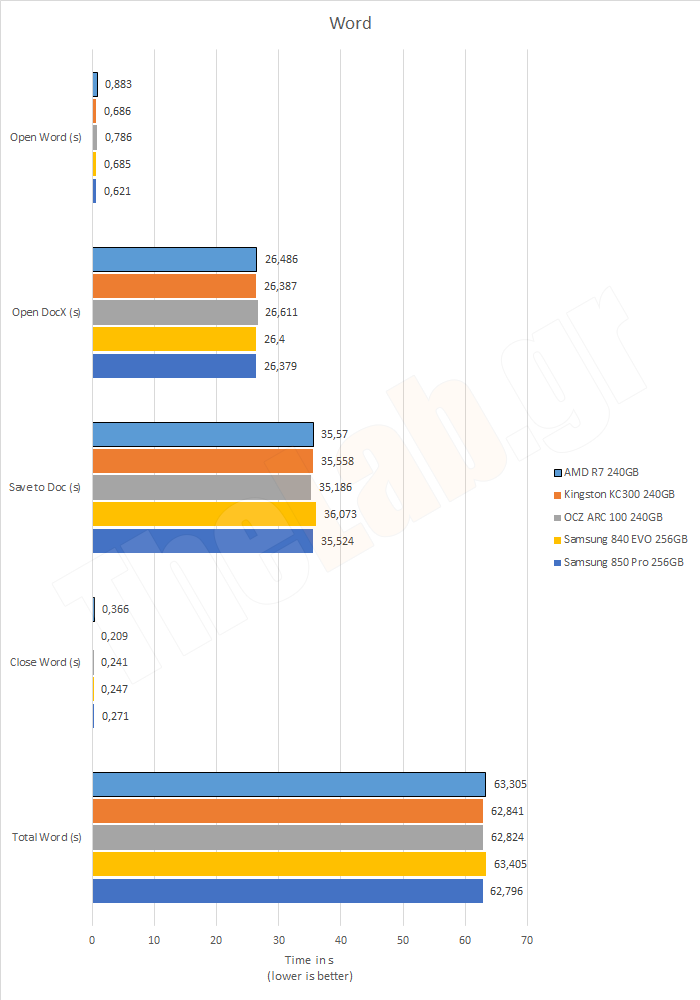
Fourth place once more for the AMD R7 240GB.
Next, we install MS Office 2013...
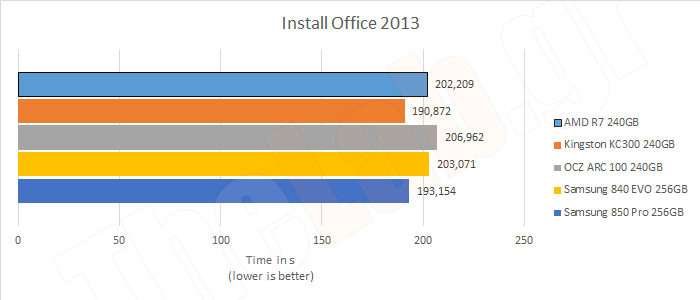
...where the best time is made by the Kingston SSDNow KC300 240GB with the Samsung 850 Pro 256GB just behind and the AMD R7 240GB getting third place.
Thus end the Real Life Tests. The last chart shows the total time of these tests where...
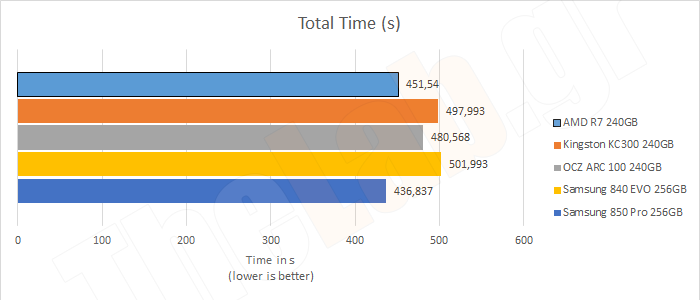
The AMD R7 240GB had the second best performance, behind the Samsung 850 Pro 256GB. Their difference is 14,703s which translates to a little less than 3,37%. Not at all bad if you keep in mind that the Samsung 850 Pro 256GB is the fastest SSD we have ever tested.
[break=Conclusions and score - To the point]
My dear Watson, the time has come to reach a conclusion. We have in our hands an SSD which AMD puts in the R7 series, which is to say, low to mid range. But it offers anything but low to mid range performance. Coming close to the fastest consumer SSD at a distance of only 3,37% and with the promise it will keep that performance even in the toughest of conditions, it is surely worthy of our attention.
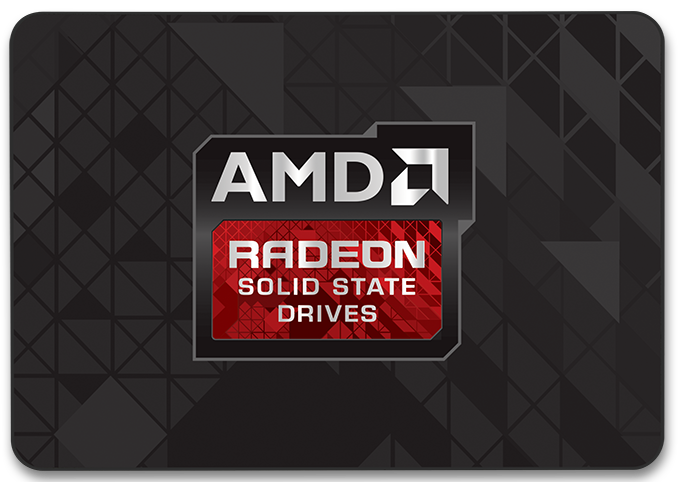
Is it worth investing in the AMD R7 240GB? The answer is, it depends. For users who use their computers lightly and don't put a lot of stress on their SSDs, the choices in the market are plenty, including the faster Samsung 850 Pro 256GB. For users who do heavy multitasking and constant writes that stress the SSD, the AMD R7 240GB is very enticing. For most people who are somewhere in the middle, let each decide where to put the weight in choosing their SSD.
Of course, we have to take into consideration that the AMD R7 240GB comes with the best warranty in terms of conditions we have ever seen, not only on an SSD but on any product!
And so we get to the score:
a) In Features, we take away a few points because the AMD R7 240GB does not have low power states (slumber and DevSleep) and just a tad more for the missing TCG Opal encryption.
![]() In Price the AMD R7 240GB is not available in the Greek market at this moment but the suggested price is 144€, including V.A.T.. The cheapest price for the Samsung 850 Pro 256GB which was the only SSD in our possession which performed better than the AMD R7 240GB is 175€, including V.A.T., in stores with availability and including shipping. That comes to a price difference of 31€, or about 21,53% while the difference in real life tests performance - which are the ones we care about the most - was 3,37%. Even if we include stores with no availability and exclude shipping the cost of the 3,37% faster Samsung 850 Pro 256GB comes to 158,68€, which is 10,19% more expensive. Some will argue that the Samsung 850 Pro comes with a 10 year warranty, which is important, but the 4 years offered by the AMD R7 240GB are not for a regular warranty, but for the new and improved Shieldplus, with great advantages. To make a long story short, we can say that according to what it offers and compared with the competition, the AMD R7 240GB achieves a great value for money. It will be marked accordingly.
In Price the AMD R7 240GB is not available in the Greek market at this moment but the suggested price is 144€, including V.A.T.. The cheapest price for the Samsung 850 Pro 256GB which was the only SSD in our possession which performed better than the AMD R7 240GB is 175€, including V.A.T., in stores with availability and including shipping. That comes to a price difference of 31€, or about 21,53% while the difference in real life tests performance - which are the ones we care about the most - was 3,37%. Even if we include stores with no availability and exclude shipping the cost of the 3,37% faster Samsung 850 Pro 256GB comes to 158,68€, which is 10,19% more expensive. Some will argue that the Samsung 850 Pro comes with a 10 year warranty, which is important, but the 4 years offered by the AMD R7 240GB are not for a regular warranty, but for the new and improved Shieldplus, with great advantages. To make a long story short, we can say that according to what it offers and compared with the competition, the AMD R7 240GB achieves a great value for money. It will be marked accordingly.
c) Usability does not have any real significance in SSDs. They all now have a 7mm height which allows for installation everywhere from a desktop to an ultrabook and, let's face it, their installation has a worst case scenario of screwing four screws. For these reasons, the Usability category will not be taken into account in the SSD Scores.
d) In the Performance department, we have a lot to discuss. It depends how one would like to approach the subject. In the synthetic benchmarks the AMD R7 240GB was mediocre. Considering that synthetic benchmarks are not indicative of performance in real use, they make a very small part of the overall score. On the contrary in Real Life Tests the AMD R7 240GB did very well and came second overall, beating strong competition. Moreover, in our sadistic tests, it scored excellent showing that it is capable of maintaining its high performance over time no matter how hard you treat it. For all of the above, its performance score will be quite high.
Advantages
- Exceptional performance in the steady state test.
- Exceptional performance in the mixed workload test.
- Steady performance over time.
- Good performance in the Real Life Tests./li>
- It includes a 3.5" adapterli>
- It includes the very well known cloning software Acronis True Image HD.
- The best warranty we have ever seen.
- Spartan but complete software.
- Multi-language installation manual.
Disadvantages
- Mediocre scores in synthetic benchmarks.
- Absence of a windows optimization tab in the Radeon Toolbox.
Based on the above, the total score of the AMD R7 240GB is:


We thank OCZ and AMD for providing the test sample

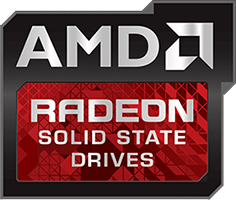
Polymeros Achaniotis 22/10/2014



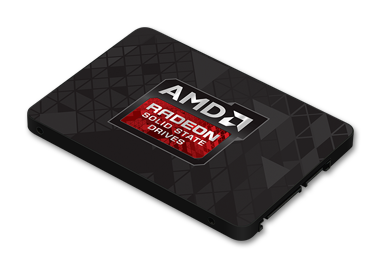










Recommended Comments
There are no comments to display.
Create an account or sign in to comment
You need to be a member in order to leave a comment
Create an account
Sign up for a new account in our community. It's easy!
Register a new accountSign in
Already have an account? Sign in here.
Sign In Now